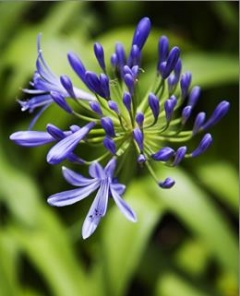Lily of the Nile, Agapanthus
| Infobox on Lily of the Nile, Agapanthus | |
|---|---|
| Example of Lily of the Nile, Agapanthus |  |
| Facts | |
| Origin | - |
| Stowage factor (in m3/t) | - |
| Humidity / moisture | - |
| Ventilation | - |
| Risk factors | See text |
Lily of the Nile, Agapanthus
Contents
Description / Shipment / Storage / Risk factors
Scientific Name and Introduction
Agapanthus africanus. Agapanthus is Greek for "love flower." The globose heads of Agapanthus are a pleasing accent for Spring and early-Summer arrangements, providing an alternative source of blue. The most common flower colour is blue, but white cultivars are also available. Miniature, dark blue (‘Storm Cloud’) and reduced-shatter cultivars have been developed.
Quality Characteristics and Criteria
Agapanthus flowers are normally harvested when the bud bract has fallen off and no more than three florets are open. Stalks are cut near their base with a sharp knife. Ensure that flowers are of proper maturity. If the neck of flowers is bent upward, they have been transported at warm temperatures and have responded to gravity.
Grading and Bunching
No formal grade standards have been established. Agapanthus flowers are bunched in groups of 5 or 10 stems.
Ethylene Sensitivity
Ethylene exposure results in loss of florets from Agapanthus.
Pretreatments
The vase-life of freshly-cut Agapanthus flowers was shown to be significantly extended by pretreatment with a 3-hr pulse in 4 mM STS, followed by spraying (to runoff) with 30 ppm NAA, followed by a 48-h pulse in a solution containing 10% sucrose, 300 ppm Citric Acid, and 300 ppm Physan-20. This pretreatment is not sufficient to counteract the decrease in vase-life due to even short-term storage and is of no apparent benefit to flowers harvested immature.
Storage Conditions
Store at 0°C to 1ºC. Even when pre-treated to prevent flower abscission, Agapanthus flower stalks stored dry at 1ºC suffer significant decrease in vase-life after only 4 days and are frequently unable to achieve a minimally acceptable number of open florets.
Packing
Agapanthus flowers are normally packed in horizontal fibreboard boxes.
Special Considerations
Premature flower fall is caused mainly by ethylene, especially for immature flower buds. The common blue cultivar ‘Mooreanus’ is much less prone to premature flower fall than the white flowering ‘Aldidus.’
Sources used
BMT Consolidated Manual on (Dutch) Flower Bulbs, cut flowers/greens and potted plants.











